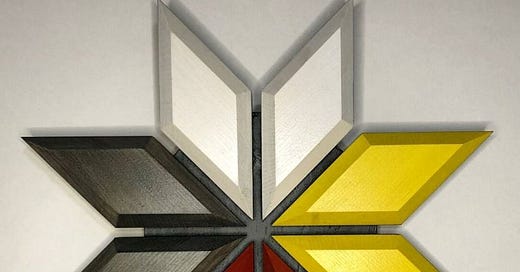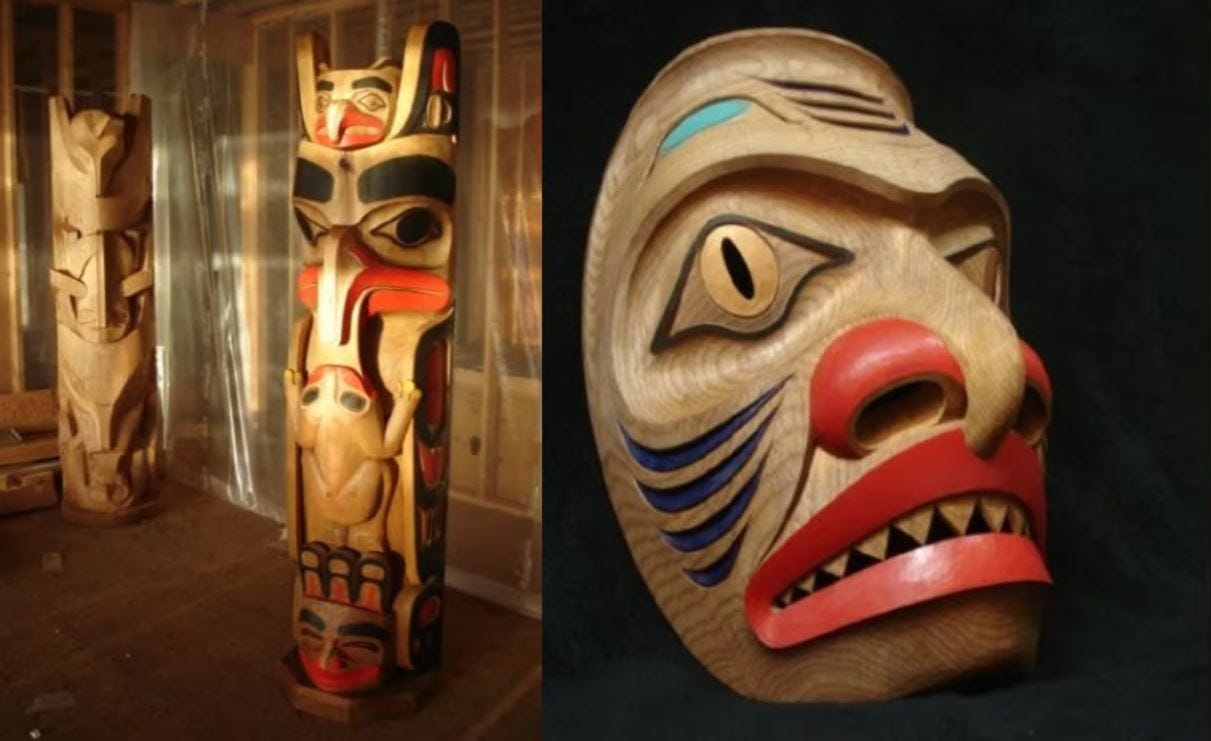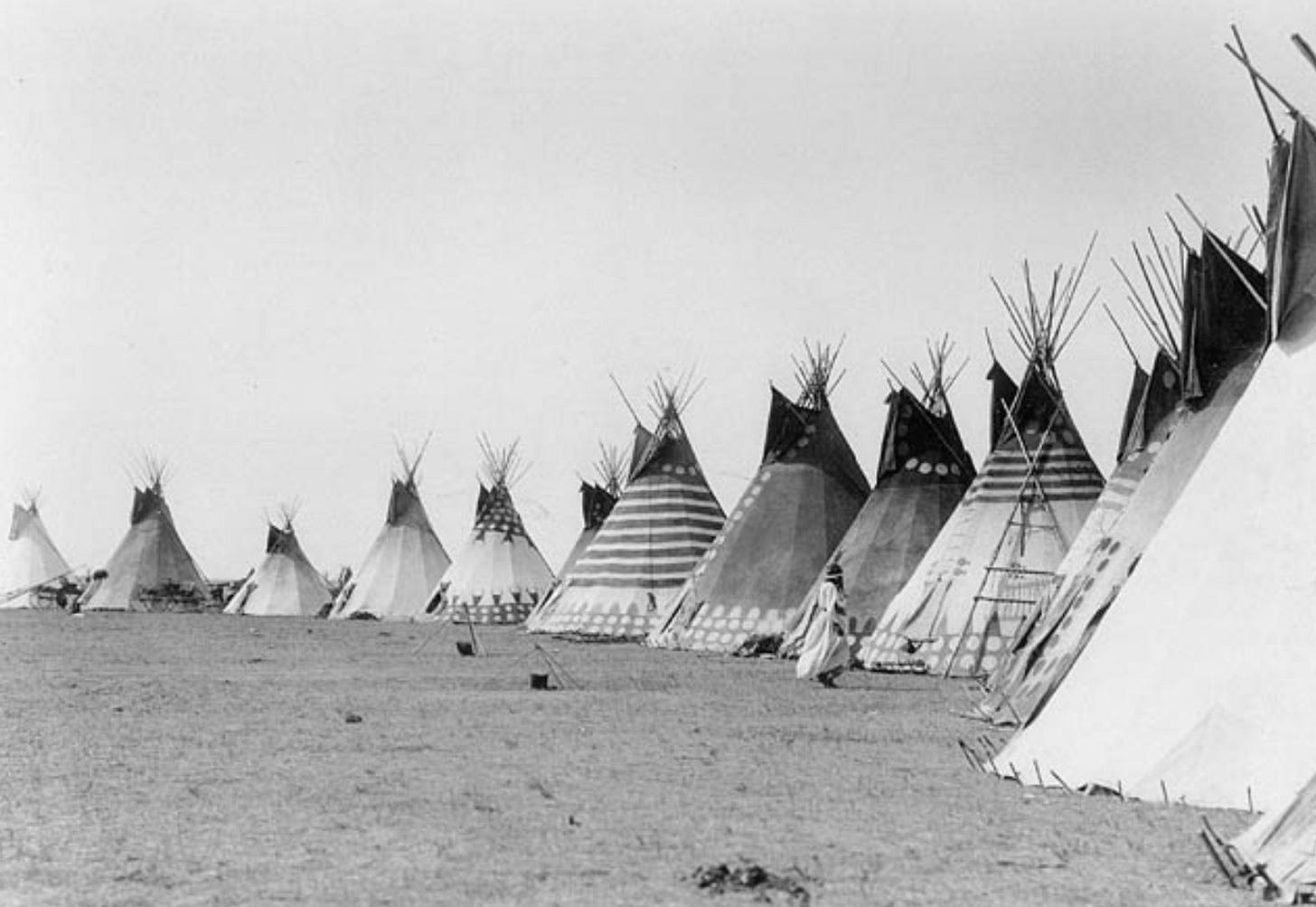The Mi’kmaq Star (see more on this below)
Totem poles are monuments created by First Nations of the Pacific Northwest to represent and commemorate ancestry, histories, people, or events. Commonly they are carved out of red cedar, a malleable wood relatively abundant in the Pacific Northwest, Totem poles were important symbols that contributed to the shaping of a community’s culture. Totem poles display beings, or crest animals, marking a family’s lineage and validating the powerful rights and privileges that the family held. Totem poles would not necessarily tell a story so much as it would serve to document stories and histories familiar to community members or to a particular family or clan.
Another part of indigenous traditions in the Pacific Northwest are ceremonial masks a created to represent people, animals or spirits. They range from relatively simple renderings to more elaborate creations that might include moving beaks or jaws. The shapes and styles vary greatly depending upon their purpose and function. Masks are designed to tell stories and to share knowledge. Some are used in dances by a single performer while others require an attendant for the mask to be used. Although contemporary masks may push the boundaries of the form, they continue to retain their cultural and historic significance.
Photo Source: https://amp.cbc.ca/news/canada/british-columbia/ben-davidson-obituary-1.5717608
These items were carved by Ben Davidson who specialized in wood sculpture and apprenticed with both his father, Robert Davidson, and his uncle, Reg Davidson.
An inukshuk on a mountain in Iqaluit, Nunavut.
(Photo credit: Jonathan Hayward/The Canadian Press)
Most Canadians are familiar with the traditional inuksuit (inuksuit is the plural of inuksuk in Inuktitut language) created by Inuit people in the Arctic. These sculptures had many functions including as guides to travelling by providing directions. They are usually built on rising ground, so that they show above blowing snow. Rows of inuksuit were built to look like rows of humans to frighten caribou and steer them towards waiting hunters. Inuksuit are not necessarily always functional. Sometimes they are built just to pass the time.
Photo Circa 1910. Photo attribution: Arthur Rafton-Canning (1864-1952), Public domain, via Wikimedia Commons
In the Blackfoot culture tipi’s are considered “sacred bundles” belonging to the Siksika Nation people. The design on the tipi is based on the origin story which is handed down from ancestors through ceremony. Each tipi has a song and represents Niitsitapiisini (the Blackfoot way of life). depicted through the paint on the upper and lower part of the tipi. The middle part of the tipi tells the story or dream that was given to the tipi owner. This practice of painting tipis has been with the Blackfoot people since time immemorial. Today the tipi’s are used for ceremonies, including the Sundance.
In Anishinaabe culture, tobacco (Asemaa) is a sacred medicine used to communicate with the spirit world, strengthen relationships, show respect, and offer prayers, and is considered a gift from the Creator. Tobacco is one of the four sacred medicines (also including Cedar, Sage and Sweetgrass). Tobacco is offered to plants so that plant will let all the plants in the area know that the person making the offer is coming to pick them. It is offered to Elders, Healers or Medicine People so they know that a request may be made for their help. Offerings of tobacco are made to spirits to express gratitude.
The Eagle Feather is a sacred symbol in Cree culture given to those who have reached extraordinary accomplishments through hard work, integrity and a willingness to learn and improve. Eagle feathers are considered one of the most sacred and honored gifts, representing a profound connection to the Creator and the natural world. Eagles are known for their strength and courage, and the feathers embody these qualities, inspiring those who carry them. Eagle feathers are used in ceremonies, dances, and other traditional practices to honor the Creator, respected guests, and to symbolize peace and friendship.
Source: https://uwaterloo.ca/indigenous/smudging
Smudging is a traditional ceremony practiced by many First Nations, including the Algonquin, for purifying or cleansing the soul of negative thoughts of a person or place. It involves placing a tightly balled-up bundle of sage (Mashkodewashk) in a smudge container. The container may be a shell; a ceramic or stone bowl; or a copper, brass, or cast-iron pan. It is then lit from the bottom with a match and placed on top of tobacco. Once lit, the smoke may be pulled towards you with your hands or pushed forward with a feather or an eagle fan. It is often practiced at the beginning of a meeting to ensure the participants think positively with open minds.
Photo Source: https://exhibitions.nysm.nysed.gov/iroquoisvillage/images/print18lg.jpg
The Mohawk people, also known as Kanien'kehá꞉ka ("People of the Flint") and the "Keepers of the Eastern Door" within the Haudenosaunee Confederacy, are symbolized by their role as the eastern most nation and their connection to the flint, representing strength and resilience. The Mohawk became wealthy traders of flint as other nations in their confederacy needed flint for tool making and as a fire starter. Their Algonquin-speaking neighbors (and competitors), the Mohicans, referred to the Kanien'kehá꞉ka as Maw Unk Lin, which means "bear people". The Dutch heard this and wrote this term as Mohawk.
The Mi’kmaq Star (depicted at top of this article above) is seen as a symbol of unity for the Mi’kmaq people, but also a symbol for the sun, which is a powerful figure in traditional spiritual life. This Mi’kmaq Star represents the four directions with white representing the north, “the land of ice and snow, where even the animals are white”. Yellow represents the east, “the land of the rising sun; Mi’kmaq (being located in the east) are the ‘people of the dawn’ ”. Red represents the South, “the further you travel in Turtle Island the warmer it becomes”. Finally, black represents the west, “which is where the sun must travel to give us night.”
These are merely a sample of the literally many hundreds of different symbols that shape indigenous cultures. Some are shared across communities while others are unique to a given people. All are sacred and meaningful. The importance of symbolism was not lost on Christian missionaries who sought to eliminate indigenous symbols in an earnest effort to eradicate indigenous culture and substitute Christian culture. For example, it was an important part of the Indian Act to make certain ceremonies illegal in order to weaken indigenous culture.
The importance of cultural symbolism cannot be overstated. Cultural appropriation and theft are egregious crimes against the indigenous people of Turtle Island because it diminishes the importance of cultural artifacts and their history as a nation. In particular, misunderstood or any replication of indigenous symbols in art or other means divorces those symbols from the original meaning and should be regarded as an insult to the sacredness of those symbols. For a settler to display an unearned Eagle feather dilutes the sacred importance of the symbol. Copying indigenous art undermines the unique expression of culture that rightfully belongs to the people who first created it in their style as an expression of their beliefs.
Canada has the unique opportunity to cherish indigenous culture and enjoy the vast diversity found amongst the first peoples of Turtle Island. We owe it to indigenous people to allow them to “own” the cultural elements that make each nation and each group of people unique unto themselves. This is precisely why we need to advocate and support the return of cultural artifacts that were stolen and placed in museums around the world. It is why we should support the revitalization of indigenous languages, religions and culture. It is a matter of respect. It is also an opportunity for the non-indigenous people in Canada to learn about indigenous peoples’ culture, represented in many ways through their art, ritural practices and items which are sacred and carry deep symbolism.









